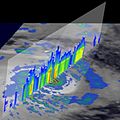File:Heta vertical.jpg

Original file (768 × 768 pixels, file size: 72 KB, MIME type: image/jpeg)
Captions
Captions
Summary edit
| DescriptionHeta vertical.jpg |
English: Collection:
NASA Earth Observatory Collection Title: Tropical Cyclone Heta Description: Heta meandered northwest of Samoa over the weekend before turning south and passing just west of the islands on Monday, January 5, 2004. Winds up to 105 miles per hour buffeted the islands knocking out power, uprooting trees, and causing extensive roof damage. After passing Samoa, Heta continued southeast and intensified with sustained winds estimated at 133 miles per hour and gusts of up to 185 miles per hour as it was headed for the tiny island nation of Niue. The Tro pical Rainfall Measuring Mission (TRMM) satellite captured these impressive images of Cyclone Heta as it was passing just west of Samoa. The images were taken at 6:08 UTC on January 5, 2004. This image shows a vertical cross section through the eye of the storm from the TRMM PR. It shows areas of heavy rainfall (red areas) extending upwards to midlevels in the eyewalls and in an outer rainband as well as deep convective towers surrounding the eye extending to upper levels (blue areas above red areas). Ano ther image shows the horizontal distribution of rain rates as seen from above by the TRMM satellite. TRMM reveals that Heta has a double eyewall structure, which can sometimes occur in mature, intense tropical cyclones. The outer eyewall, the intense band of heavy, 2-inch-per-hour rain rates shown by the dark red circle completely surrounds a partial inner eyewall shown by the smaller dark red semicircle. Tropical cyclones act as large heat engines. When water vapor condenses into the cloud droplets that form the precipitation, heat, known as latent heat, is released and drives the storm. Generally, the more heat that is released, the more powerful the storm will become. This heating is also most effective near the center of the storm as is the case with Heta. TRMM is a joint mission between NASA and the Japanese space agency NASDA. Images produced by Hal Pierce (SSAI/NASA GSFC) and caption by Steve Lang (SSAI/NASA GSFC) Satellite - Sensor: TRMM facet_what: Tropical Cyclone facet_what: Tropical Rainfall Measuring Mission (TRMM) facet_where: Niue facet_where: Samoa facet_where: Goddard Space Flight Center (GSFC) facet_when: January 5, 2004 facet_when_year: 2004 UID: SPD-ETOBS-11898 original url: http://earthobserva… Image ID: 171588 Resolution Size: 4 Format: JPEG Media Type: Image File Name: heta_vertical_trmm20 04005_lrg.jpg Width: 852 Height: 852 |
| Date | |
| Source | www.nasaimages.org |
| Author | NASA |
Licensing edit
| Public domainPublic domainfalsefalse |
| This file is in the public domain in the United States because it was solely created by NASA. NASA copyright policy states that "NASA material is not protected by copyright unless noted". (See Template:PD-USGov, NASA copyright policy page or JPL Image Use Policy.) |  | |
 |
Warnings:
|
File history
Click on a date/time to view the file as it appeared at that time.
| Date/Time | Thumbnail | Dimensions | User | Comment | |
|---|---|---|---|---|---|
| current | 02:53, 17 June 2010 |  | 768 × 768 (72 KB) | Dr Brains (talk | contribs) | {{Information |Description={{en|1=Collection: NASA Earth Observatory Collection Title: Tropical Cyclone Heta Description: Heta meandered northwest of Samoa over the weekend before turning south and passing just west of the islands on Monday, January 5, 20 |
You cannot overwrite this file.
File usage on Commons
There are no pages that use this file.
Metadata
This file contains additional information such as Exif metadata which may have been added by the digital camera, scanner, or software program used to create or digitize it. If the file has been modified from its original state, some details such as the timestamp may not fully reflect those of the original file. The timestamp is only as accurate as the clock in the camera, and it may be completely wrong.
| _error | 0 |
|---|